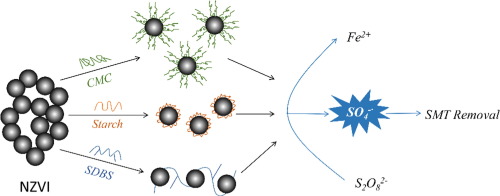Separation and Purification Technology ( IF 8.1 ) Pub Date : 2019-07-29 , DOI: 10.1016/j.seppur.2019.115869 Haoran Dong , Qin Ning , Long Li , Yaoyao Wang , Bin Wang , Lihua Zhang , Ran Tian , Rui Li , Jie Chen , Qianqian Xie

|
In this study, bare nanoscale zero-valent iron (NZVI) and that modified by starch, carboxymethyl cellulose (CMC) and sodium dodecyl benzene sulfonate (SDBS) were compared for their ability in activating persulfate to degrade sulfamethazine (SMT) in aqueous solution. The influencing factors, i.e., mass ratio of stabilizer/NZVI, pH, groundwater components (e.g., Ca2+, HCO3−, SO42− and humic acid) and particle aging, on SMT removal were examined. The results showed that there was an optimal mass ratio of stabilizer/NZVI for the stabilized NZVI (50 wt%, 0.1 wt% and 0.5 wt%, respectively, for starch-, SDBS- and CMC-stabilized NZVI) in order to achieve a faster removal rate of SMT than the bare NZVI. There was no significant difference among different nanoparticles in SMT removal in pure water at pH 5 and 9. While in simulated groundwater, the SMT removal in the bare NZVI system was more inhibited than the stabilized NZVI system. Compared with that in pure water, the removal rate of SMT was markedly decreased in simulated groundwater, especially at pH 9, which might be due to the radical scavenging effect of groundwater components (e.g., HCO3−, humic acid, SO42−) and the buffering effect of HCO3−. The aging of nanoparticles decreased the reaction rate. After aging for 15 d, SMT removal was decreased from 71.6%, 83.2%, 81.9% and 72.4% to 58.8%, 61%, 59.1% and 52.9%, respectively, for bare, starch-, SDBS- and CMC-stabilized NZVI in the first 5 min. However, SMT could still be completely removed in all systems when the reaction time was prolonged to 1 h. XRD analysis of the aged nanoparticles indicated that both bare and stabilized NZVI were not significantly oxidized in the air, and could still be employed for the activation of persulfate.
中文翻译:

裸露的和表面稳定的纳米零价铁活化过硫酸盐去除磺胺二甲嘧啶的比较研究
在这项研究中,比较了裸露的纳米零价铁(NZVI)以及经淀粉,羧甲基纤维素(CMC)和十二烷基苯磺酸钠(SDBS)改性的零价铁在水溶液中活化过硫酸盐以降解磺胺二甲嘧啶(SMT)的能力。的影响因素,即(稳定剂/ NZVI,pH值,地下水成分的质量比率例如Ca 2+,HCO 3 -,SO 4 2-和腐殖酸)和颗粒的老化,对SMT的去除进行了检查。结果表明,为了获得稳定的NZVI,存在最佳的稳定剂/ NZVI质量比(对于淀粉,SDBS和CMC稳定的NZVI,分别为50 wt%,0.1 wt%和0.5 wt%)。 SMT的去除率比裸NZVI更快。在pH为5和9的纯水中,不同纳米颗粒的SMT去除没有显着差异。而在模拟地下水中,裸露NZVI系统中的SMT去除比稳定的NZVI系统受到的抑制更大。与在纯水中进行比较,SMT的去除率在模拟地下水显着下降,特别是在pH为9,这可能是由于地下水组分的自由基清除效果(例如,HCO 3 - ,腐殖酸,SO 42-)和HCO的缓冲效果3 - 。纳米粒子的老化降低了反应速率。老化15天后,裸露,淀粉,SDBS和CMC稳定的NZVI的SMT去除率分别从71.6%,83.2%,81.9%和72.4%降至58.8%,61%,59.1%和52.9%。在最初的5分钟内 但是,当反应时间延长到1小时时,仍然可以在所有系统中完全去除SMT。老化的纳米粒子的XRD分析表明,裸露的NZVI和稳定的NZVI在空气中均未显着氧化,仍可用于过硫酸盐的活化。































 京公网安备 11010802027423号
京公网安备 11010802027423号